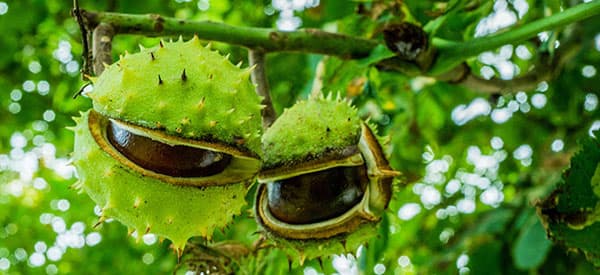
Horse Chestnut
Horse chestnut (Aesculus hippocastanum) is a flowering tree often found lining city streets and landscaped gardens. Its name was derived from the tree’s horseshoe-shaped twigs that remain once the leaves fall off. The conkers of nuts were also used as a traditional medicine for horses’ cough. But while the conkers are beneficial to horses, they are poisonous to smaller animals.
In 1616, horse chestnut was introduced to the UK from Greece and Albania. It was naturalized and used as trees for lining roads and was valued for its spring flowers and conkers. Britain and Ireland were the first to use conkers in children’s games where they tie the nuts into a string. The two players will take turns striking each other’s conkers until one of them breaks.
Where Horse Chestnut Is Found
Horse chestnut is abundant in Europe but is also found in the United States and temperate regions of Asia. They thrive in the wilds of Greece and Albania but can be grown worldwide under favorable weather conditions. They are often found in many parks and streets as ornamental trees for shade because of their wide canopy.
⇒ Medicinal Plant Map for Every State (Video)
How To Identify Horse Chestnut
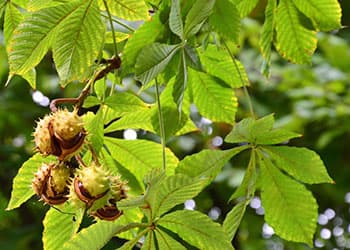
Horse chestnut adds a striking visual interest to landscaping, especially during its flowering season. It is a large, broad-crowned tree with large leaves that turn yellow or gold in autumn. It bears showy flowers that are creamy-white in color and also turn red as it matures.
Leaves. Horse chestnut leaves are palmately compound or with divided leaflets. Some may have 5 to 9 leaflets, but the most common is seven. The leaflets are wedge-shaped, rounded near the tip end. It also has an abrupt taper into a point at the tip-most part. Their edges are wavy and finely-toothed with a hairless upper surface and densely-haired underside.
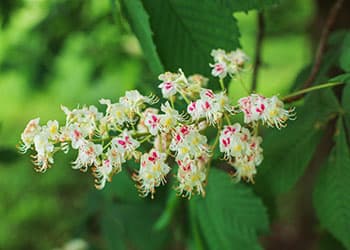 Flowers. The flowers of the horse chestnut tree can be creamy white, gold, or burgundy. They grow in 5 to 12-inch panicles or branched inflorescence. Each flower has a yellow throat and a red speckled center. The petals are spreading and irregularly rounded with seven protruding stamens longer than the petals. They are joined by a calyx in a bell-shaped formation.
Flowers. The flowers of the horse chestnut tree can be creamy white, gold, or burgundy. They grow in 5 to 12-inch panicles or branched inflorescence. Each flower has a yellow throat and a red speckled center. The petals are spreading and irregularly rounded with seven protruding stamens longer than the petals. They are joined by a calyx in a bell-shaped formation.
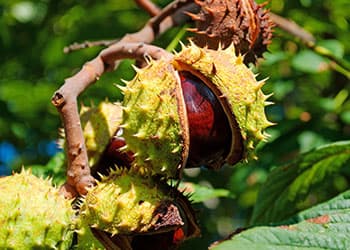 Fruits and Seeds. Stiff spines cover the fruits of horse chestnut. The fruit is fleshy, globular, and golden brown with a leathery spiked surface. It contains about one to three large, shiny, and dark reddish-brown nuts, each with a pale scar or “eye.”
Fruits and Seeds. Stiff spines cover the fruits of horse chestnut. The fruit is fleshy, globular, and golden brown with a leathery spiked surface. It contains about one to three large, shiny, and dark reddish-brown nuts, each with a pale scar or “eye.”
Roots. Horse chestnuts have a strong, deep, and extensive root system. It has a woody taproot and shallow and extensive lateral roots that grow vast across the outline of the canopy.
Trunk. The horse chestnut tree can grow to about 50 to 70 ft tall with a trunk that can span up to 3 ft in diameter. It has dark and rough outer bark that grows flaky as the tree grows older. The branches and twigs are stout and brown with a resinous coat at the bud.
⇒ Plant Identification Guide – 400 Wild Plants That You Can Forage For (Video)
Aesculus hippocastanum is a flowering tree of the Sapindaceae or soapberry family. It is known by names such as common horse chestnut, conker tree, European horse chestnut and Marronnier Commun.
Horse chestnut is a highly toxic tree. When ingested, it becomes highly poisonous and leads to severe reactions. The poison comes from its raw seeds, bark, flowers, and leaves.
- European horse chestnut is the only species native to Europe but there are 13 other species found throughout the northern hemisphere and Asia. There are two cultivars or varieties of horse chestnut:
- Baumann’s horse chestnut produces double white blooms but without nuts
- Red horse chestnut is shorter than the common horse chestnut
How To Grow Horse Chestnut
Horse chestnut is ideally grown in a large garden to add interest to the landscape. They are best for border planting and for adding shade to the lawn.
You can grow horse chestnuts from its seeds or its cuttings. However, propagating them may require patience and time since it is difficult to grow. Its seeds have a germination rate of only 50% and you need to choose them carefully.
The seeds that fall off the tree naturally are viable for planting once they are fully matured. You will need seeds that do not have cracks and insect damage. To ensure a higher possibility of growth, you can plant as many seeds as you can to see how many will germinate.
Some online seed stores do sell viable horse chestnut seeds for planting. You may also check your local nursery for any available saplings.
⇒ The Most Important Thing That’s Probably Missing From Your Backyard (Video)
Growing Horse Chestnut From Seeds
Before handling horse chestnut seeds, make sure to wear gloves since it contains toxins that are harmful when ingested.
Cold stratification can facilitate faster seed germination. Seeds that remain outside in winter can be planted immediately as they already undergo enough chilling. Otherwise, you can put them in the fridge for at least two weeks before planting. You will know that the seeds are viable when they sink into the water.
Sow horse chestnut seeds in spring, in containers with draining holes filled with rich and well-draining soil. You can let the container chill outside after planting if you like. Keep the soil moist but not soggy until horse chestnut seedlings emerge.
Transfer the seedlings to their permanent location when they already outgrow their pots. Choose a location where it can get some sun but will not dry out.
When transplanting horse chestnut, make sure that the saplings are placed straight before backfilling it with soil. The hole should be wide and deep enough to accommodate them. Fill the hole with water and allow them to get absorbed before adding the plant and backfilling. Add mulch on top to help it retain moisture and keep the weeds away.
Growing Horse Chestnut From Cuttings
Cutting propagation is the easiest way of growing a horse chestnut tree if you have a source plant. Prune the tree for softwood cuttings in spring, or you may also choose hardwood cuttings in autumn. Unlike other plants, the youngest and immature horse chestnut tree will reproduce best than the matured ones.
Clip off the terminal end of the branch about an inch in diameter, and take off 4 to 6 inches long. Scrape off the bark from the bottom in two different spots to encourage better rooting. You may dip it in a rooting hormone before planting though it is not necessary.
Plant the cuttings in well-draining potting soil with a mixture of sand or perlite. Keep the pot away from direct sunlight and keep the soil moist. If planting them in the same pot, allow about 3 to 4 inches of space between them.
Do not tug on the roots. Instead, wait for the leaves to sprout. Harden the seedlings before transplanting them when the dangers of frost have passed.
Plant Care And Maintenance
Horse chestnut requires little maintenance before it becomes established. The plant will do better if it has the following favorable growing conditions: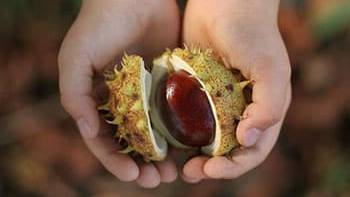
- Full sun to partial shade
- Well-draining but moist and rich soil
- Acidic soil with a variable range of pH
- Frequent moisture
- Granular, liquid, or organic fertilizer
Horse chestnuts are prone to fungal infections like leaf blight. Leaf miner or moth larvae may also feast on the plant as well as bacteria that can cause canker bleeding. Destroying the infected part may help save the plant and stop the spread of infection.
How To Harvest Horse Chestnut
Conkers are collected in early autumn as soon as they fall off the tree and come out of their husks. Gather these seeds and chop them while they are still fresh and soft. You can do this using a serrated knife to cut them into pieces. When conkers harden, they will become more difficult to cut.
Horse chestnut seeds are made into a tincture by infusing the chopped conkers in vodka for a few weeks.
When gathering leaves for oil, pick the leaves during spring before the horse chestnut flowers open. These are also infused with extra virgin olive oil for a month and used as oil for skin problems.
What Horse Chestnut Is Good For And Natural Remedies Made From It
While the whole part of the horse chestnut tree is toxic, its oil extract has many medicinal uses.
The most noteworthy action of Aesculus hippocastanum oil is in the treatment of chronic venous insufficiency (CVI). CVI, also known as phlebitis, occurs when the valves in the vein fail to function. It causes blood to pool in the veins and increase its pressure. Varicose veins and deep vein thrombosis are the risk factors for CVI.
The most common treatment for CVI is compression, which can be a bit discomforting. But, random trials prove the efficacy of horse chestnut extract in managing CVI. It is safe for short-term use and horse chestnut extract cream is used for treating varicose veins.
Additionally, horse chestnut is also an effective cure for rheumatoid arthritis and other arthritic pain.
Horse chestnut is also traditionally used in treating frostbite because of its anti-inflammatory property.
Quercetin and kaempferol glycosides are two important antioxidants found in horse chestnuts. These are excellent in fighting damaging free radicals making horse chestnut a potential plant for cancer treatment. It may also cause cell death in certain types of cancer like leukemia, cervical cancer, and breast cancer.
Aescin is another compound found in horse chestnut supplements. It can help increase sperm count and support fertility in men.
Horse chestnut has traditional and modern medicinal values not limited to the following: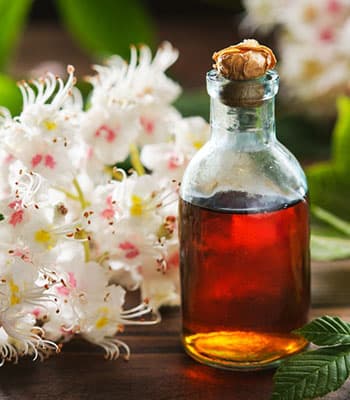
- Chronic venous insufficiency and its risk factors
- Cancer
- Male fertility
- Wound healing
- Inflammations
- Chest pain and respiratory ailments
- Rheumatoid arthritis
- Premature skin aging
- Frostbite
- Edema and phlebitis
- Malaria and dysentery
- Hemorrhoids
⇒ How to Turn This Annoying Plant into a Vein Cleanser (Video)
What Parts Of Horse Chestnut Are Used For Remedies
Horse chestnut is inedible and dangerous when ingested raw because it contains a toxic saponin called esculin. The safe way of consuming horse chestnut is taking its processed form. Standardized seed extracts remove the toxic compound and will make horse chestnut safe but only for a short time.
As an herbal remedy, horse chestnut is available in the following forms: tincture, ointment or cream, capsule.
Horse Chestnut Oil
Ingredients:
- 25 g horse chestnut
- 125 ml olive oil
Steps:
- Grind horse chestnut as much as you can.

- In a heatable bowl, pour olive oil and mix well.

- Fill a small pot with about a quarter of water. Place the bowl with chestnut and olive oil on top of the pot. Turn on the stove in medium heat with a temperature between 40 to 42⁰C (104 – 107.6⁰F). Stir the mixture every fifteen minutes while maintaining the temperature for 2 hours. Check the amount of water from time to time, and add more if needed.

- Allow the oil to cool, strain the oil in a clean jar and discard the chestnuts. Label the jar accordingly.

How To Use This Remedy
Massage horse chestnut oil in varicose veins or spider veins one to two times a day.
When using horse chestnut supplements, the recommended daily dose is 400 to 600 mg divided into two dosages.
What Plants Resemble Horse Chestnut
| Features | Horse Chestnut (Aesculus hippocastanum) | Sweet Chestnut (Castanea sativa) | Buckeye (Aesculus glabra) |
|---|---|---|---|
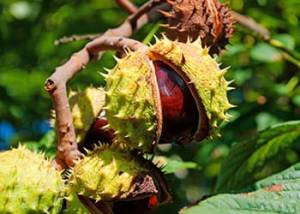 | 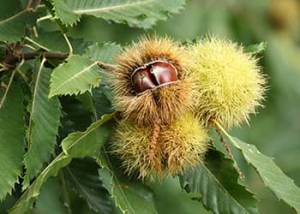 | 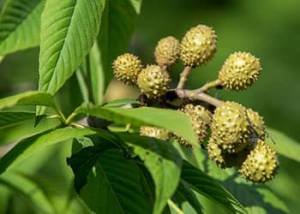 | |
| Size | 50 to 70 ft | 80 to 100 ft | 20 to 40 ft |
| Leaves | Green to gold; palmately compound; 7-lobed; wedge-shaped; finely serrated | Green to gold; simple; lance-shaped; serrated | Green; palmately compound; 5 to 7 leaflets; serrated |
| Flowers | White/gold/burgundy; panicle; irregularly rounded | Gold/ green; string-like inflorescence (catkins) | Gold/ green; panicle; 4 petals |
| Fruits/Seeds | Fleshy; globular; leathery; spiked; reddish-brown nut with eyes | Spiny protective husk (burr); shiny reddish-brown nut with a tuft at the end | Prickly, leathery capsule; shiny brown seed with eyes |
| Trunk | Dark; rough; flaky bark; stout branches; resinous | Net-like pattern in the bark; deep grooves | Dark gray; smooth trunk |
| Scent | Odorless | Fried mushroom-like scent | Fetid smell |
Warnings and Cautions
Horse chestnut is highly toxic and fatal when eaten. When it is in its processed form, usage should not exceed the recommended daily dose. It should also be taken for no more than 6 months.
Its safety is not yet established, thus, persons with the following conditions should avoid using horse chestnut supplements:
- Pregnant and breastfeeding
- Bleeding disorders
- Diabetes
- Digestive problems
- Liver diseases
- Latex allergy
- Kidney disease
- Scheduled for surgery
Horse chestnuts will interact with lithium, diabetes medication, and anticoagulants. Always follow the labels when using any herbal supplement and consult your doctor or qualified herbalist before using them.
You may also like:
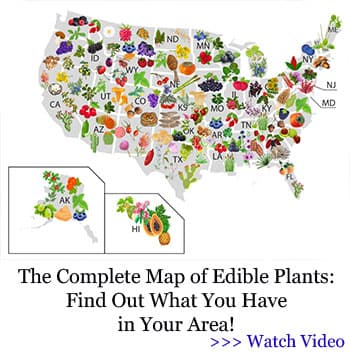 5 ‘Miracle Trees’ The Native Americans Used For Medicine
5 ‘Miracle Trees’ The Native Americans Used For Medicine
How to Make Bark Bread from a Tree that Grows on Almost Every Street in America (Video)
How To Treat Varicose Veins With Chestnuts

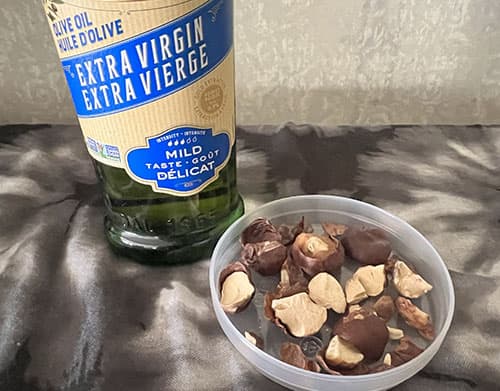
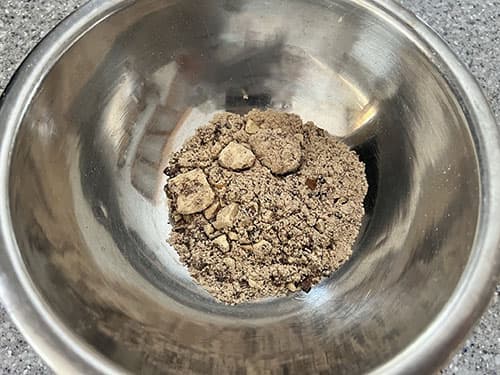
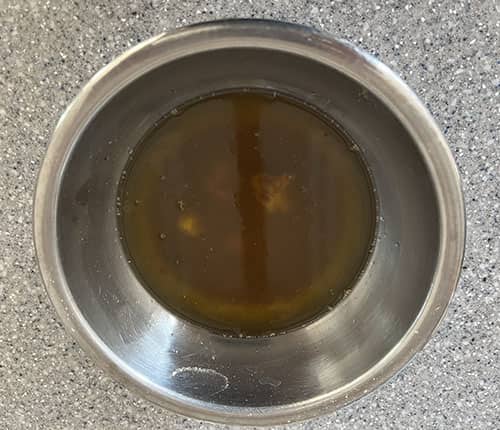
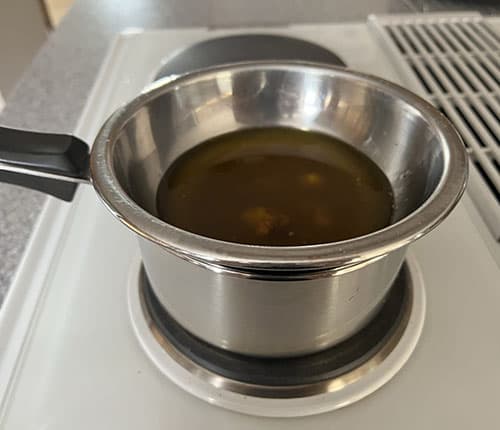
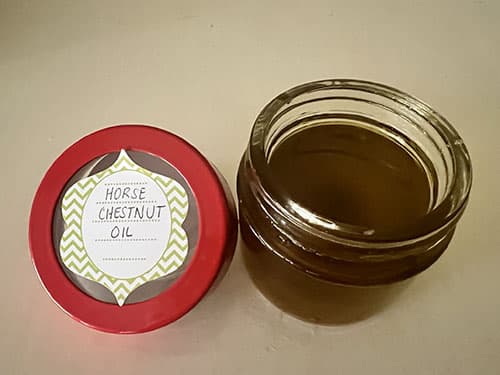
That’s so very interesting. I wonder why people who have a latex allergy are included in the list of disorders to avoid horse chestnut.
Hello Jackie,
Thank you for your interest in our article. People who are allergic to latex might also be allergic to horse chestnut.
Many blessings and good health!
Ok i need something explained to me about this what is the difference between horse chestnut and chest nut that we eat ??? i though they were the same thing
They’re very, very different, Larry. The horse chestnut can kill you whereas the sweet chestnut is healthy and delicious, so you definitely have to learn the difference! (Some online research will help.)
Hello Larry,
Horse chestnuts, unlike sweet chestnuts, are inedible because contain poisonous saponins. Externally, the two types of chestnut differ as well. Their fruits have distinct shapes, shells, and the appearance of their leaves and flowers is also different.
The spiny husk is one of the most distinguishing characteristics of horse chestnuts and sweet chestnuts. Even though the fruit casings of the chestnuts appear similar at first glance, a closer inspection reveals distinct differences. Horse chestnuts have a leathery husk with sparse, pointed thorn-like spines, whereas sweet chestnut husks are spiny and needle-like.
Many blessings and good health!
We call these Buckeyes in my part of the country (WV, Ohio, Kentucky), I believe. Apparently, though, there is a difference between the horse chestnut and the buckeye. Both are poisonous to humans. As children, we would take a buckeye seed and carry it around in our pocket, rubbing it for “good luck.” The more we rubbed the buckeye, the more shiny it would become! The bloom distinguishes the horse chestnut tree from the buckeye tree, with the horse chestnut tree being prized as an ornamental. When a regular true chestnut tree blooms, you can smell it—they smell terrible (to me)! I am happy to have learned something here in reading about horse chestnuts. I will be on the lookout for a horse chestnut tree now! Thank you!
Hello Paula,
Thank you so much for sharing this fond childhood memory with us.
We really appreciate it, and we’re happy to hear you enjoy the article.
Many blessings and good health!
I am more interested in the chestnuts that we can roast and eat around Christmas. We should learn to grow the edible ones. I can buy them in the store but they are expensive.
Hello Tom,
Thank you for your comment.
Unlike horse chestnuts, which are poisonous to humans, sweet chestnuts are edible. Their nuts can be roasted and used in a wide range of dishes, such as stuffing for chicken, cake fillings, nut roasts, and more.
Many blessings and good health!
When you get old this information can resolve many of your health & leg problems & even be a life saver.
Hello James,
Thank you for your kind words. It’s heartwarming to hear that our article is helping people gain valuable knowledge about natural remedies.
Many blessings and good health!
Horse chestnut is awesome! I suffered from an anal fissure (it’s basically a tiny “paper cut” in the wrong place), trying various hemorrhoid products which didn’t help at all . Then on an internet forum, I finally discovered horse chestnut (herbal capsules twice a day, also applied a topical cream) and the relief was awesome. Eventually I was prescribed a prescription ointment, which I used for a while and it worked, but I found the horse chestnut to be equally effective or more so, and I returned to using horse chestnut instead of the Rx. Both the Rx and the horse chestnut worked by increasing circulation to the area to promote healing.
Thank you, Ria. Could you tell me what the dosage was on the capsules? How many milligrams did you take? We are treating a similar condition.
And where did you get the capsules and ointment?
hemorrhoids are very easy to kill with cold water . just shower your ass whit it and they will be gone very fast. Just do it.
Hello Ria,
Thank you so much for posting this.
Horse chestnut seed extract’s anti-inflammatory properties has been reported indeed to aid in the relief of hemorrhoid symptoms, by reducing inflammation and swelling in the affected veins.
Many blessings and good health!
Can buckeyes be used in place of horse chestnuts in the recipe?
Hello Carissa,
Buckeye is not very popular for its medicinal benefits, comparing to horse chestnut. Buckeyes can be made into a nourishing salve for rashes or wounds, but it’s also helpful for arthritis pain.
For the recipe presented in the article, it is best to use Horse Chestnut.
Many blessings and good health!